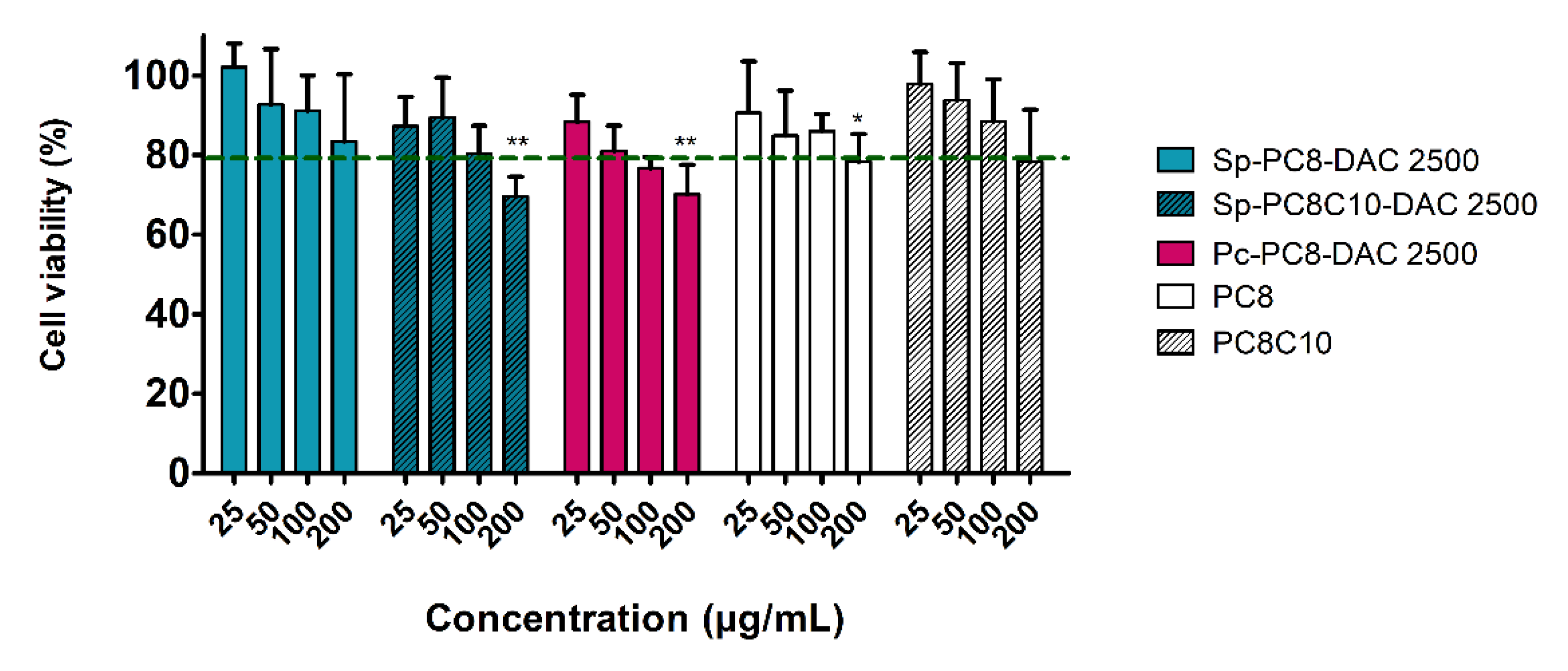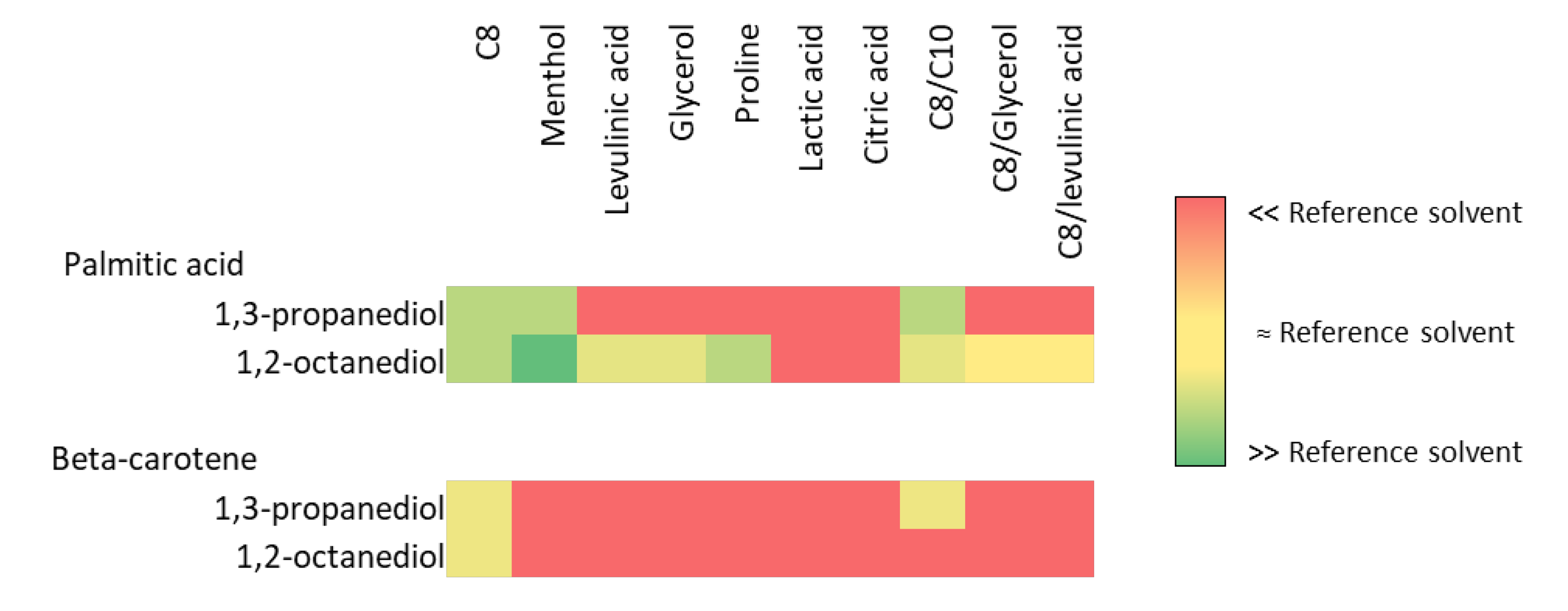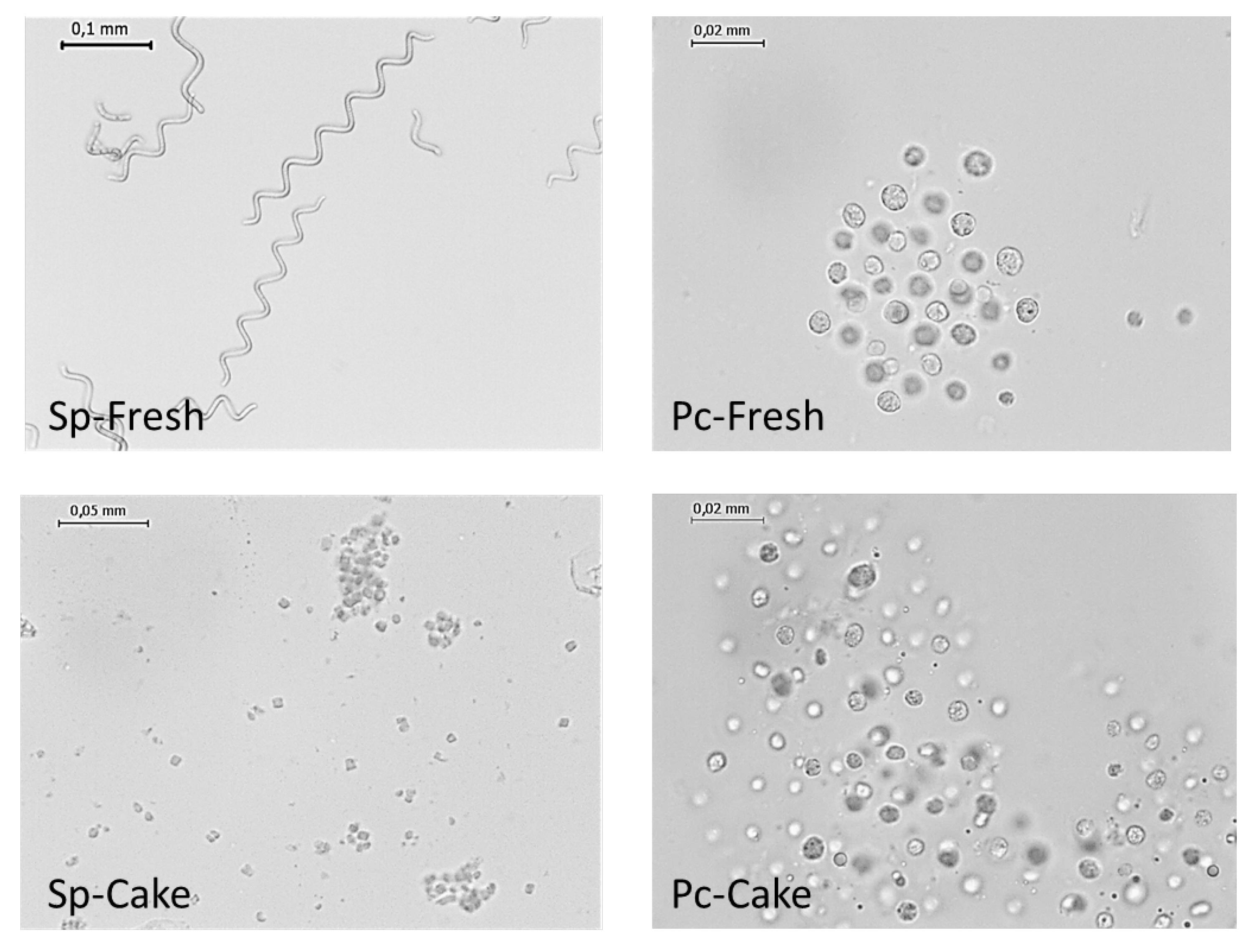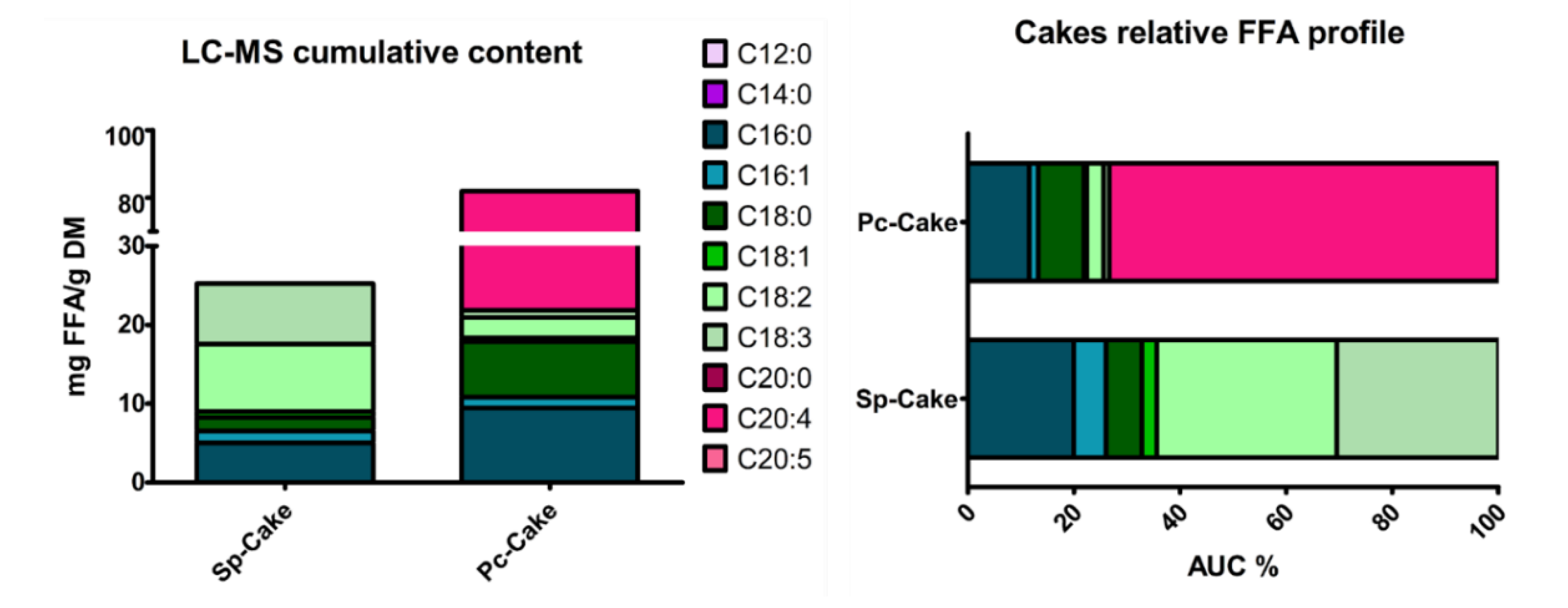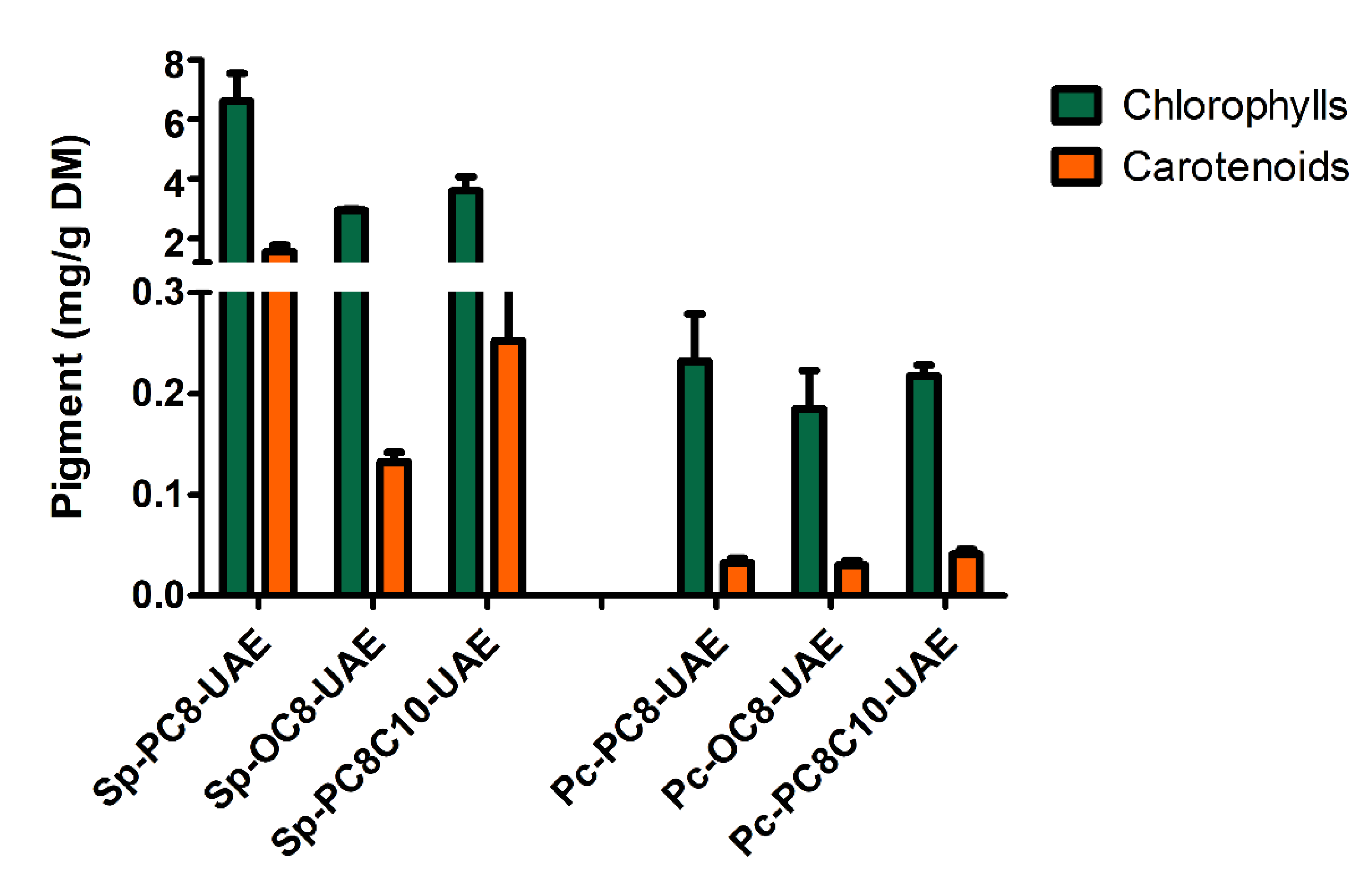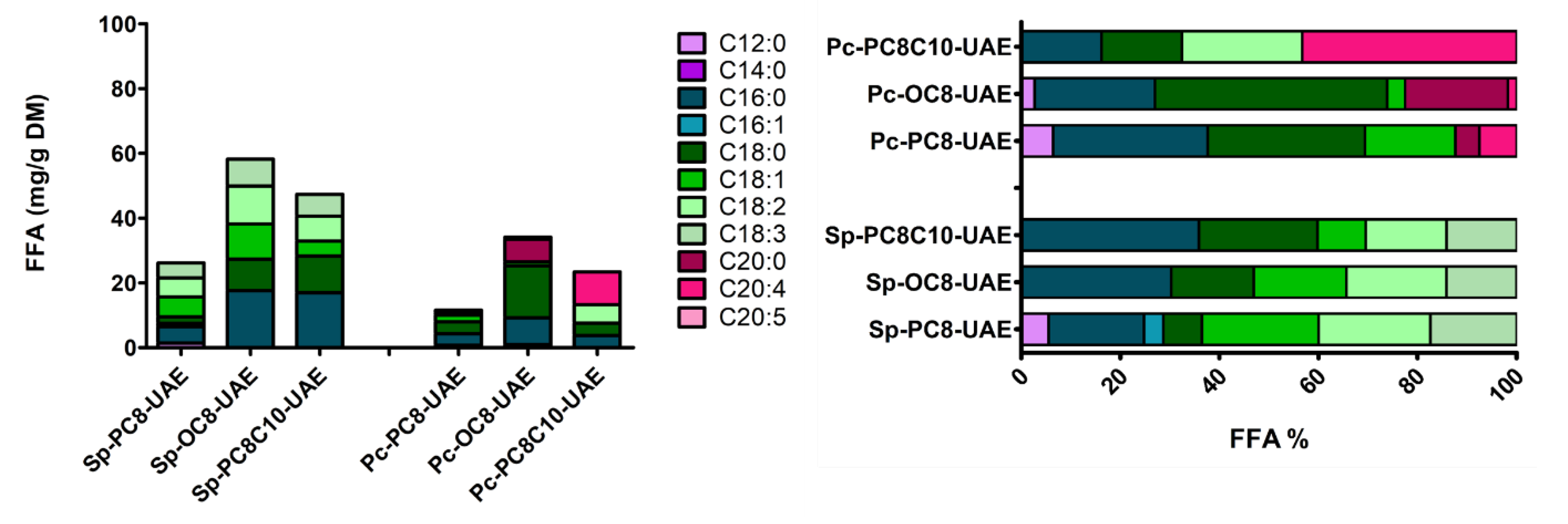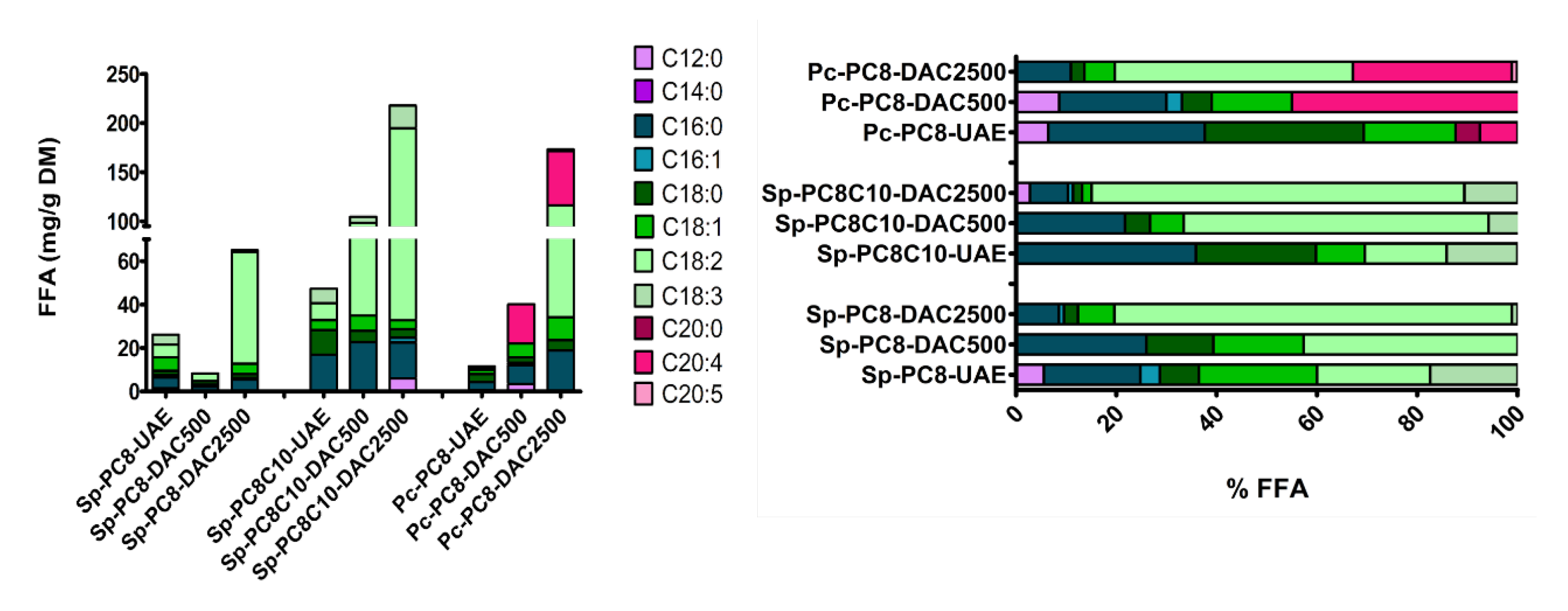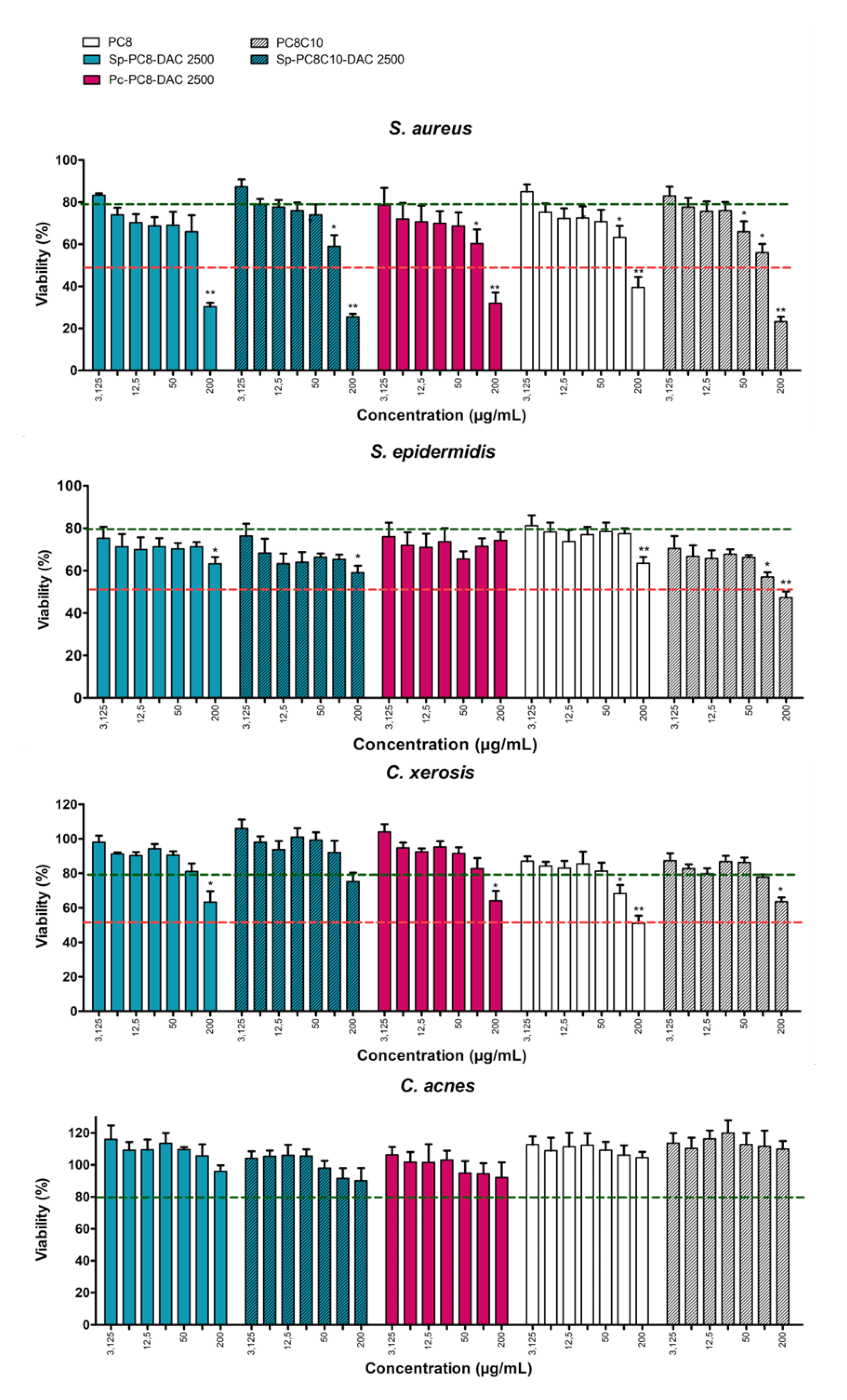1. Introduction
Microalgae represent a unique sustainable resource of biomolecules for several industrial sectors, including the cosmetic and food industries. Microalgae can produce numerous types of biomolecules, such as proteins, pigments (phycobiliprotein, carotenoids, chlorophylls), polysaccharides, and lipids, with particular emphasis on their abundance of polyunsaturated fatty acids (PUFA) [
1].
Microalgae were usually used as powder or global extract, targeting one class of metabolite for one defined species. For example, Spirulina (
Arthrospira platensis) or
Porphyridium cruentum were extracted for their high content of phycobiliproteins (phycocyanin and phycoerythrin, respectively) [
1]. Phycobiliproteins (PBP) are highly promising metabolites exhibiting antioxidant, anti-cancer and anti-inflammatory activity [
2,
3,
4]. The growing demand of phycobiliprotein-concentrated product in food market led to the extraction of increasing amount of microalgal biomass, using water as the main solvent [
4]. By-product generated were usually used as is, even if other high value metabolites like free fatty acids (FFA) could be still valorized. Spirulina is known to present a wide profile of FFA, especially rich in polyunsaturated fatty acids (PUFA) [
5].
P. cruentum exhibited a more limited FFA profile, generally characterized by a high amount of long chain PUFA, especially arachidonic (C20:4) and eicosapentanoic acids (C20:5) [
6].
In fact, FFA were potential new topic antibiotics, as they were known as physiological skin microbiota regulators [
7,
8]. One major possible valorization of microalgae FFA is cosmetic market to produce active ingredient to regulate skin microbiome. In fact, unbalanced skin microbiota is linked to various skin disorders like dryness, eczema, or atopic dermatitis (AD) [
9,
10,
11]. Especially, a predominance of
Staphyllococcus aureus was reported in lesional skin of patients suffering from AD [
9,
10]. One alternative strategy to antibiotic treatment is the prevention of
S. aureus proliferation by topical addition of moisturing agent and/or physiological microbiome regulator like FFA [
11,
12]. In this case, PUFA were highlighted as main class of interest exhibiting both microbiota regulation and moisturing effect [
7,
12].
With the growing demand of PBP enriched product for food and cosmetic market, an increasing amount of PBP’s extraction by-products is generated each year, that could be considered as an opportunity for FFA valorization. FFA are generated during PBP extraction by lipidome degradation due to intense thermal and agitation treatment, explaining that they are usually considered as lipidome degradation indicator in biofuel production. FFA are still industrially extracted using toxic solvents such as chloroform/methanol or hexane/methanol mixture, but greener alternatives were recently described like Natural Deep Eutectic Solvents (NaDES) [
3,
13,
14].
In a thermodynamically point of view, NaDES refers to liquids prepared by mixing pure compounds that displays significant negative deviation from ideality, owing to their eutectic point temperature being considerably lower than that of the ideal mixture [
15,
16]. NaDES are obtained by mixing hydrogen bond-donors with a hydrogen-bond acceptor using a suitable molar ratio, based on natural compounds. They are mostly composed of primary metabolites, such as organic acids, amino acids, and sugars [
16]. Hydrophobic DES (HDES) were recently introduced in the literature [
17,
18,
19,
20]. Those HDES were composed of a combination of menthol or thymol with sugars, polyols or fatty acids or a combination of short chain fatty acids [
17,
18,
19,
20,
21,
22].
DES were usually described as powerful solvent for microalgal biomass pre-treatment in biofuel production [
23]. Recently some DES were reported as valuable solvent for algal hydrophobic metabolites extraction. Fucoxanthin and chlorophyll of a diatom,
Thalassoria andamanica, were extracted using a set of DES based on benzyltriethylammonium and fatty acids [
24]. Fucoxanthin wax also extracted from an alga,
Tisochrysis lutea, using NaDES based on fatty acid and terpene, like Thymol/C8 [
25]. A set of HDES based on oleic acid and terpene, like thymol or geraniol, was also screened for asthaxanthin extraction from
Haematococcus pluvialis [
26]. Considering microalgae lipids, omega 3 lipid were recovered from
Nannochloropsis using choline chloride-based DES but was focusing on ester lipid and not FFA [
27]. Our group have recently reported the extraction of FFA from fresh spirulina biomass using a panel of NaDES [
3,
13,
14]. Fatty acid based NaDES, especially (C9/C10/C12, 3:2:1, mol/mol/mol), were reported as solvent with high capacity of FFA solubilization, but were highlighted as more specific of saturated FFA [
3,
14]. Fatty acid-based DES were also reported as potential antimicrobial media for drugs vectorization [
28]. NaDES based on menthol and alkanediol (1,3-propanediol, 1,2-octanediol) were also highlighted as selective solvent for monounsaturated FFA (MUFA) and PUFA but with lower solubilization capacity [
13].
Indeed, to produce ready-to-use cosmetic ingredient for skin microbiota regulation, NaDES components should be in line with European and Chinese cosmetic regulation, which exclude choline chloride, and most of the terpene considered as allergens [
29]. Combining FFA, natural skin microbiota regulators, with antimicrobial DES based on fatty acids, should result in enriched extracts that could favor the regulation of microbiota diversity and prevent the
S. aureus-associated dysbiosis, linked to skin disorders such as AD or sensitive skin.
In this work, we explored the design of a new class of HDES based on alkanediol to improve PUFA extraction performances. NaDES solubilization capacity towards carotenoids and palmitic acid was investigated. The most performant NaDES were screened on cakes of Spirulina and P. cruentum, resulting of PBP water extraction. Two extractions process were challenged: ultrasonic extraction and an innovative dual asymmetric centrifugation (DAC). A selection of resulting extracts was then tested on keratinocytes and four bacterial species of skin microbiota to highlight potential benefit for skin dysbiosis prevention.
2. Results and Discussion
2.1. Alkanediol-Based NaDES Design and Characterization
Alkanediol based NaDES were already described in the literature, mostly combined with chlonine chloride, for polar metabolites extraction [
30,
31,
32]. Some recent work reported the interest of combining alkanediol with different HBA to enhance the extraction of hydrophobic metabolites like terpenes [
33], and curcumin [
34]. Most of the NaDES described then were either not compatible with a cosmetic use or too polar to extract FFA. Our lab recently highlights the potential of Menthol-alkanediol combination to extract PUFA from fresh Spirulina biomass [
13], highlighting the potential of alkanediol for our purpose.
To design our alkanediol-based NaDES library, the Smart NaDES selection strategy recently described by our group was applied [
13]. Raw materials were first selected in accordance with European and Chinese cosmetic regulations [
29], to avoid the metabolites/NaDES separation step. Two alkanediols were then selected: 1,3-prodanediol and 1,2-octanediol, as HBD components. To prepare a wide range of alkanediol based NaDES, HBA of large range of polarity were selected from glycerol to octanoic acid (
Table 1).
Most of the alkanediol based NaDES produced were easy to prepare using stirring and heating protocol, at low temperature (between 50 and 60 °C) except for NaDES containing citric acid. In general, the density was acceptable for extraction process (between 0.88 to 1.28). Especially, NaDES based on alkanediol and fatty acids exhibited the lowest density, allowing easy transfer and handling (
Table 1).
Water miscibility of resulting alkanediol-based NaDES was then investigated. In fact, microalgal cakes were media with low dry matter content. Therefore, NaDES of interest should not be miscible to water to avoid high water amount transfer during extraction step, that could impact extract preservation. Only alkanediol combination with almost one fatty acid or menthol or proline were found to be immiscible to water.
To select the most relevant NaDESs, the solubilization capacity of each NaDES was explored on two reference compounds: β-carotene to mimic carotenoids of interest in cakes, and palmitic acid to explore FFA solubilization capacity. Alkanediol-based NaDES performances were compared to well-known reference solvents: hexane/acetone (60:40,v/v) for carotenoids and ethylacetate for palmitic acid.
Solubilization results were shown on the heatmap in
Figure 1.
Considering carotenoids, only three NaDES have shown performances similar to the reference hexane/acetone mixture: PC8, PC8C10 and OC8. β-carotene with high unsaturated structure could provide a good approximation of both carotenoids and PUFA behavior in NaDES.
The three NaDES combining good performances either for palmitic acid or β-carotene were then selected to perform cakes extraction: PC8, PC8C10, and OC8.
2.2. FFA Extraction Using Hydrotrope-Based NaDES
2.2.1. Cakes Characterization
A. platensis and
P. cruentum pretreated cakes were first characterized as starting point. Impact of the preliminary phycobiliproteins extraction on cell integrity was investigated at both macroscopic and microscopic levels. Dyes and lipid content were titrated. Also pigments diversity and FFA profile were established using HPLC and LC-ESI-MS analysis. The dry matter (DM) rate of the biomasses was measured by gravimetry (
Table 2).
A. platensis was morphologically characterized by long, unbranched, spirally coiled filaments. Length and curl might vary depending on growing conditions. The fresh biomass (Sp-Fresh) exhibited a typical long spiral structure, about 250 µm long, as the dominant form (
Figure 2). The
A. platensis cake, by-product of PBP water extraction, exhibited a dramatic cellular damage with only cellular debris visible. The cells were individualized, ranging from 5 to 7.5 µm length (
Figure 2).
P. cruentum is represented by cells with spherical shape, ranging size from 5 to 7 µm, red to brown. As for Spirulina, fresh biomass (Pc-Fresh) exhibited negligible impact on the cell wall as typical spherical structures were observed (
Figure 2). Surprisingly, the preliminary extraction of PBP (Pc-cake) did not seem to impact dramatically the cell structure but we can observe several shining and empty cells with a length around 4–5 µm.
The preliminary extraction of PBP had then an important impact on cell-wall in both cases, which may favor the mass transfer during lipid extraction process. This data was a crucial point to investigate the possibility of sequential extraction of PBP and FFA. Moreover, in the case of FFA, the cellular damage could be a good indicator of FFA rate, as they are recognized as lipidome degradation indicator. Targeting FFA here appeared then a smart strategy to up-cycle these microalgae wastes.
Considering FFA profile, Sp-Cake highlighted a high ω6-PUFA content, as linoleic and γ-linolenic acids, in accordance with literature (
Figure 3) [
5]. Lower levels of palmitic acid were observed (above 25%), differing from the usual medium rate of 40% found in the litterature [
5]. Sp-Cake exhibited the highest FFA rate (25 mg/g DM), as we could expect according to cell wall degradation.
Considering
P. cruentum, FFA profile highlighted a high level of arachidonic acid (C20:4, ω6), almost 80% of total FFA (60 mg/g DM) (
Figure 3). These amounts were 5-fold higher than those usually found in the literature [
6]. Low levels of eicosapentaenoic acid (EPA, C20:5, ω3) were observed, as well as low rates of palmitic (C16:0) and linoleic acid (C18:2, ω6). Those FFA were usually described at higher rates [
6].
Considering pigment profiles of Spirulina and
P. cruentum cakes, as we can see in
Table 1 spirulina exhibited higher chlorophylls and carotenoids’ content than
P. cruentum. Sp-Cake content reached 4.4 mg/g DM for chlorophylls and 1.6 mg/g DM for carotenoids, in comparison with
P. cruentum that exhibited content close to 2 mg/g DM and 1 mg/d DM of chlorophylls and carotenoids respectively.
2.2.2. Ultrasound Assisted Extraction (UAE)
First UAE was explored to extract FFA using the three selected NaDES PC8, PC8C10 and OC8. UAE was already described as a green and relevant technology to extract FFA from spirulina cakes using conventional solvent [
3].
As we can see on
Figure 4, the pigment profile of all extracts was almost similar for
P. cruentum and closely related for spirulina. The main difference was the lower amount of carotenoids found in OC8 extract of spirulina cake.
Considering now the FFA extraction (
Figure 5), OC8 and PC8C10 exhibited the best extraction performances on both cakes, with a FFA amount between 50-60 mg/g DM spirulina, and 20-30 mg/g DM
P. cruentum. PC8 perfomances were twice lower with amount of 25 mg/g DM and 15 mg/g DM for spirulina and
P. cruentum respectively.
The main target of interest in FFA pool are the unsaturated ones (MUFA and PUFA). On
Figure 5, for Spirulina cake extraction, it appeared clearly thatPC8 was the most performant NaDES regarding MUFA and PUFA selectivity (67% of FFA profile) followed by OC8 (53 %) and PC8C10 (40%). For spirulina, PC8 appeared then as the best NaDES for our purpose combining high carotenoids and PUFA amounts, even if recovery should be improved. OC8 and PC8C10 exhibited closely related performance considering FFA. However, given the lower carotenoids levels observed in OC8, PC8 and PC8C10 were selected for spirulina extraction.
On
P. cruentum, the most performant NaDES was the PC8C10 with unsaturated FFA rate of 67% of the FFA profile. It was important to note that this high amount was mostly composed of arachidonic acid, and that no MUFA were observed and as well as low level of linoleic acid. PC8 with lower unsaturated FFA (25%) exhibited on the contrary a more diversified profile, in accordance with the envisaged extract use. In fact, it has been shown that FFA diversity favored of a better microbiota balance [
7,
8,
12]. OC8 exhibited the lowest selectivity again towards PUFA (only 5% of FFA). Thus, considering
P. cruentum, only PC8 was selected for further investigation.
2.2.3. Dual Asymmetric Centrifugation (DAC) Extraction
Recently, our group explored an innovative mechanical extraction, the Dual Asymmetric Centrifugation (DAC), to enhance flavonoids and carotenoids extraction from marigold with NaDES [
35]. This new process allowed to work at room temperature with higher extraction recovery thanks to intense mixing between biomass and NaDES.
As PC8 and PC8C10 use for cakes extraction led to interesting FFA profile but with moderate recovery, DAC was investigated as alternative extraction process. In fact, as DAC process is performed at room temperature, in comparison with UAE that generated temperature rising during extraction (up to 50°C), this alternative process could prevent PUFA and MUFA degradation and then increase their extraction.
Extraction time (30 min) remains identical to UAE, but the rotation speed was modulated as it has a major impact on mixing intensity. Two rotation speed were then investigated: a low one (500 rpm) and a high one (2500 rpm).
As shown in
Figure 6, the pigment recovery increased with speed rotation for both microalgae cakes. With PC8 the carotenoids amount increased 6-fold, from 1.5 mg/g DM using UAE to 8 mg/g DM with DAC at 2500 rpm. The performance of DAC at 2500 rpm was even more impressive on
P. cruentum (10-fold) and with PC8C10 on spirulina (25-fold).
Considering FFA recovery, the use of DAC process, particularly at 2500 rpm, dramatically improved the extraction performances for all NaDES screened and the two microalgae cakes.
Considering Spirulina, FFA amount raised from 26 mg/g DM to 65 mg/g DM with PC8 and from 47 mg/g DM to 218 mg/g DM for PC8C10. It is also important to note that the FFA profile, using the DAC process, was then dominated by PUFA and MUFA (almost 90% of FFA). In particular, linoleic acid (ω6 PUFA) represented 79 and 74% of the FFA fraction of Sp-PC8-2500 and Sp-PC8C10-2500 extracts, respectively. This is particularly interesting for cosmetic use as linoleic acid is well known as a major inflammation and microbiota regulator for skin [
7,
10,
12].
Considering P. cruentum, FFA amount raised from 11 mg/g DM to 173 mg/g DM using PC8C10. Again, MUFA and FFA relative proportion increased to reach almost 90 % of the FFA profile, with a more diversified profile. Indeed, linoleic acid was found at an equivalent rate to arachidonic acid. This extract exhibited then a more interesting profile for our purpose.
The DAC process at high rotation speed was an interesting option to considered to enhance FFArecovery from PBP extraction cakes, especially MUFA and PUFA. During all extraction experiments, the temperature was maintained below 35°C, that could explain the preservation of PUFA in the extracts.
Three samples were then selected to be biologically investigated: Sp-PC8-2500, Sp-PC8C10-2500 and Pc-PC8-2500.
2.3. Biological Evaluation for Cosmetic Use
Before considering a potential cosmetic use of our alkanediol based NaDES extract, the harmlessness on skin and the impact on microbiota were preliminary investigated, using keratinocytes, the most abundant cell type of the epidermis, and four bacterial species of the skin microbiota.
To separately highlight NaDES and metabolites effects, all experiments were performed using NaDES alone and resulting extracts.
2.3.1. Impact on Keratinocytes Viability
To investigate the safety of NADES and extracts for dermatological applications, the in vitro viability of HaCaT cells, an immortalized human keratinocytes line, was evaluated after a 24h treatment using the XTT colorimetric assay, which measures cellular metabolic activity, and lactate dehydrogenase (LDH) release assay, a marker for cell lysis. The concentrations of the compounds were set at 25, 50, 100, and 200 µg/mL, as described by Wils et al. [
14]. In addition to a negative control (unstimulated cells), a DMSO control was considered as the NaDES and extracts were diluted in DMSO. No impact of DMSO was observed at the highest concentration.
Figure 8.
Cell viability of keratinocytes after treatment with alkanediol-based NaDES or NaDES extracts (XTT assay). Results are expressed as percentage of cell viability relative to unstimulated control cells. Data represent the mean ± SEM of four independent experiments. *p < 0.05, **p < 0.01, ***p < 0.001.
Figure 8.
Cell viability of keratinocytes after treatment with alkanediol-based NaDES or NaDES extracts (XTT assay). Results are expressed as percentage of cell viability relative to unstimulated control cells. Data represent the mean ± SEM of four independent experiments. *p < 0.05, **p < 0.01, ***p < 0.001.
Overall, except for the Sp-PC8-2500 extract and PC8C10 NADES, a significant decline in cell viability is observed only at the maximum concentration of 200 µg/mL in comparison to control cells. Subsequently, cell viability gradually increases to 90–100% as the concentration decreases for all samples tested. Alkanediol-based NaDES and their extracts thus appear to exhibit satisfactory safety on keratinocytes, as cell viability is approximately 80% at the highest concentration. This slight toxicity is in accordance with the established cosmetic standards established by Caprin et al. [
36], which permit a viability of 80% for 1% (v/v) of NaDES or extract diluted in the culture medium. This concentration range is between 8 and 20 µg/mL, depending on the density of the considered NaDES or extracts. Consequently, all of the samples can be considered safe, with the viability of keratinocytes only being impacted for concentrations at least 10 times higher. As there is no significant difference observed between NaDES and the extracts, it can be concluded that the cytotoxicity is mainly due to the presence of NaDES.
To validate these findings, a second cytotoxicity test, the LDH release assay, was then carried out. The results obtained did not indicate plasma membrane permeabilization or cell death for all samples tested even at the highest concentration tested (data not shown). Therefore, the cytotoxicity observed in the XTT test can be attributed to a slowing down of metabolism rather than real cytotoxicity. To ensure the cells were healthy (adherent and alive), a microscopic control was also conducted. Microscopy did not indicate any morphological abnormalities in the treated cells, confirming the absence of cytotoxicity in the literal sense.
To date, only three publications have evaluated the toxicology of NaDES on HaCaT cells. These studies found that all of the hydrophilic NaDES tested did not show cytotoxicity on keratinocytes [
14,
36]. Regarding the cytotoxicity of hydrophobic NaDES on HaCaT, Silva et al. examined the toxicity of DES derived from menthol and fatty acids (lauric, stearic or myristic acids) [
28,
37]. These DES exhibited cytotoxicity at concentrations of 12 mM and the presence of menthol was found to be correlated with toxicity. Those data were confirmed by the study of Wils et al., that demonstrated the cytotoxicity of NaDES based on menthol, with 76% of cell viability observed at 200 µg/mL. Fatty acid-based NaDES exhibited also a cytotoxicity at high concentrations (200 µg/mL) of 57% and 56% cell viability for e C8/C12 and C9/C10/C12 NaDES respectively [
14]. It was then interesting to note that de alkanediol/fatty acids combination described here appeared to be safer for keratinocytes.
2.3.2. Impact on Skin Microbiota Bacterial Strains
Cell viability was also assessed in bacteria from the skin microbiota using the XTT assay. The tests were conducted on four Gram-positive species:
Corynebacterium xerosis,
Cutibacterium acnes,
Staphylococcus epidermidis, and
S. aureus, the latter of which is associated with atopic dermatitis severity. The cytotoxic profiles induced by NaDES and their extracts at concentrations ranging from 200 μg/mL to 3.125 μg/mL are presented in the following figure (
Figure 9).
A dose-response effect is observed in the two species of Staphylococci, whereby an increase in compound concentration is accompanied by a decline in cell viability (
Figure 9). At 200 µg/mL, except for Pc-PC8 on
S. epidermidis, all the compounds are highly deleterious, with a viability of less than 30% for
S. aureus and 65% for
S. epidermidis. Except for Pc-PC8 and PC8 on
S. epidermidis, the difference with the control is also significant at 100 µg/mL for most of them, with a viability of close to 60–70%. For the other concentrations tested, viability rises slowly with increasing concentration. At the minimum concentration, 100% viability is not achieved. The antibacterial activity seems linked to the presence of NaDES, with few differences between the extract and NaDES alone, except on
S. epidermidis, where NaDES have more advanced antibacterial activity than extracts.
The other two bacterial species,
C. acnes and
C. xerosis, are much less impacted (
Figure 9). Regarding
C. acnes, viability is close to 90–100% for all conditions, with no significant difference between the control and the highest concentration tested. In contrast, compounds at 200 µg/mL appear to be toxic for
C. xerosis, with a viability of 50–70%. At 100 µg/mL, viability reaches at least 80%, except for PC8 for which viability remains significantly reduced. For all concentrations and solvents combined, the cytotoxic activity of the extracts on
C. xerosis is lower than that of the corresponding NaDES, particularly at the lowest concentrations (
p < 0.05). This observation is important in the approach developed here, as it highlights a protective effect of the extract regarding the intrinsic toxicity of the solvent. It can be reasonably concluded that the combined effects of the extracts and NaDES would result in a slowing of the metabolism of
Staphylococci species, which are known to be predominant in the dysbiosis of the skin microbiota associated with atopic dermatitis. The fact that the viability of commensal strains, such as
C. xerosis or
C. acnes, is less or not impacted can favor the skin microbiota to tend towards a rebalance. Spirulina extracts appear to be the most promising, with this duality of effect observable from 50 µg/ml.
Hydrophobic alkanediol-based NaDES therefore appear to have increased toxicity on Staphylococcal species compared to the commensal flora. This is consistent with the results previously published by our group on fatty acid based NaDES [
14]. Many authors have shown that low concentrations of saturated FFA are bacteriostatic but higher concentrations cause lysis of bacteria [
8,
12,
38]. The mechanism of toxicity of (Na)DES on bacteria remains poorly understood despite research which has intensified in recent years. Just like on eukaryotic cells, toxicity varies with the concentration and composition of DES. The authors assume that the toxic effect would be linked to the disruption of cell walls, due to the presence of delocalized charges. The toxic effect would be accentuated by the presence of an organic acid (acidic pH) and would be less marked in the presence of NaDES containing water, surely due to the dilution of the NaDES leading to lower toxicity by distention of the network hydrogen bonds [
39]. Nevertheless, the antibacterial effect is an advantage for NaDES in the context of their use, particularly in the biomedical, agri-food or cosmetic fields. In addition to potential activity on microbiota and pathogenic germs, this intrinsic activity would also make it possible to avoid the addition of controversial inputs such as antimicrobial preservatives. NaDES based on fatty acids and alkanediols therefore showed anti-staphylococci activity. At the same time, the extracts appear more beneficial for the commensal bacteria. Hydrophobic NaDES formulations can therefore be considered as a regulator of the microbiota in the case of
S. aureus-associated dysbiosis, particularly in the context of atopic or atopic-prone skin.
3. Materials and Methods
3.1. Raw Material
Spirulina (Arthrospira platensis) (harvested and extracted in July 2019) and Porphyridium cruentum (harvested and extracted in August 2020) cakes were kindly provided by Aqua Eco Culture (Lamballe, France). All the biomasses were stored at –20°C. Cakes were obtained after extraction of phycobiliproteins using internal Aqua Eco Culture process.
3.1.1. Microscopy
The cells before and after phycobilliproteins extraction were observed under trinocular microscope LEICA L3000 and photographed using a digital camera LEICA EC3 (Leica Camera AG, Wetzlar, Germany). Photos were edited with the LEICA associated software LAS EZ version 1.6.0.
3.1.2. Dry Matter Determination
Dry matter content was determined using gravimetry. Briefly, 1 g of biomass was introduced in infrared moisture meter MB23 (Ohaus, Nänikon, Switzerland) until stable mass was observed.
3.2. Chemicals
Ethyl acetate (EtOAc), methanol (MeOH), acetonitrile (ACN), acetone, hexane and propan-2-ol were purchased from Carlo Erba (Val de Reuil, France). Ammonium formate, DMSO and saturated and unsaturated fatty acids standards kit were purchased from Merck-Sigma Aldrich (Saint-Quentin Fallavier, France). Palmitic acid (99%), octanoic acid (99%), levulinic acid (98%), betain (98%), L-proline (99%), 1,3-propanediol (98%), and 1,2-octanediol (98%) were purchased from Acros Organics (Geel, Belgium). Formic acid was purchased from Fisher Scientific SAS (Illkirch, France). Nonanoic acid 98%, decanoic acid 99% and beta-carotene (99%) were purchased from Alfa Aesar (Haverhill, USA). Water was purified using a Milli-Q system (Millipore Corporation, Bedford, MA, USA). Formic acid LC-MS grade was purchased from Fisher Scientific SAS (Illkirch, France).
3.3. NaDES Preparation and Characterization
3.3.1. NaDES Preparation
NaDES were prepared by mixing appropriate ratio of HBA and HBD (see
Table 1). The mixture was heated at 50°C or 80°C and stirred until a colorless liquid was obtained.
3.3.2. Density
NaDES density in g/mL was determined by withdrawing one milliliter of NaDES with automatic pipette set for viscous liquid (AutoRep Rainin, Brand, Wertheim, Germany) and weighing on a precision balance (Pioneer, Ohaus, Nänikon, Switzerland). All mesures were performed in triplicates.
3.3.3. Water Miscibility
1 mL of water was added to 1 g of NaDES in a graduated hemolysis tube. Phases were mixed at 30°C under magnetic stirring for 1 hour. The samples were then visually analyzed for volume check of each phase. NaDES was considered as non-miscible with water if NaDES phase volume exhibited less than 20% variation.
3.3.4. Palmitic Acid and Beta-Carotene Solubilization Ability
For palmitic acid, 500 mg of solvent was added to a 1.5 mL Eppendorf tube, then the appropriate amount of palmitic acid was added, according to the desired concentrations: 20 mg/mL, 50 mg/mL, 100 mg/mL and 200 g/mL. Solubilization was ensured by a 30-minute ultrasonic cycle (RK-100H, Bandelin electronic, Berlin, Germany). Solubilization was visually checked: clear sample was considered as soluble; non-homogeneous sample or precipitate was considered as saturation limit. NaDES performances were compared to EtOAc, as biosourced reference solvent.
For beta-carotene, 500 mg of solvent was added to a 1.5 mL Eppendorf tube, then the appropriate amount of palmitic acid is added, according to the desired concentrations: 1.0 mg/mL, 2.5 mg/mL, and 5 mg/mL. Solubilization was ensured by a 30-minute ultrasonic cycle (RK-100H, Bandelin electronic, Berlin, Germany). Solubilization was visually checked: clear sample was considered as soluble; non-homogeneous sample or precipitate was considered as saturation limit. NaDES performances were compared to hexane:acetone (60:40, v/v), as reference solvent.
3.4. Extraction Process
3.4.1. NaDES Screening and UAE
Biomass was extracted with NaDES using protocol described in [
3], without modifications.
3.4.2. Dual Asymetric Centrifuge Extraction
Spirulina and P. cruentum cakes were extracted using an asymmetric Hauschield Speedmixer DAC 150 (MP2E solutions, France) the following parameters below. C8/Prop (5:1, mol/mol) and C8/C10/Prop (3:1:1, mol/mol/mol) (3g) and cakes (0.6 g) were introduced in appropriate vial. Samples were then extracted at 500, 2500 or 3500 rpm for 30 min.
Resulting extracts were then recovered after centrifugation at 16200g (Rotanta 460R, Hettich, Sarreguemines, France)
3.5. Analytical Protocols
All extracts and the initial biomass were analyzed in terms of pigment content, lipid content and FFA and pigment profiles. Spirulina extracts were named “Sp-X” and P. cruentum were named “Pc-X” according to the solvent used. For example, resulting extract of Spirulina obtained with 1,3-propanediol:C8 was named “Sp-PC8”.
3.5.1. Pigment Content
Initial biomasses were characterized in terms of global dye content. Biomasses were extracted by water under magnetic agitation during 2 hours with biomass dry matter/solvent ratio (1/25, w/w). 1 mL of each sample were centrifuged during 10 minutes with a Mini-Centrifuge (Fisher Scientific SAS, Illkirch, France). The supernatant was then recovered and distributed in 96 well microplates. Absorbance was measured at 620, 652 nm for C-phycocyanin and 565 nm using a Multiskan GO plate reader (ThermoFisher Scientific, Villebon Coutaboeuf, France) with SkanIt RE software. Resulting solid residues were then dissolved in 1 mL of MeOH and absorbance was measured at 450, 645 and 666 nm. Mass concentration of B-phycoerythrin was obtained thanks to equation described by Benett et al. [
40] and the calculations for chlorophylls and carotenoids were established using the equation described by Boutin et al. [
41]. Error was expressed as standard deviation.
NaDES extracts were characterized in terms of chlorophylls and carotenoids content according to Wils et al. [
14]
3.5.2. Dye Profile
The qualitative chlorophylls/carotenoids profile was determined using high-performance liquid chromatography (HPLC) based on Jaime et al. [
2]. The samples from the titration assay were then filtered through a syringe filter with a porosity of 0.45 µm and transferred into HPLC vials. The samples were analyzed on a Dionex U3000RS HPLC chain equipped with a diode array (Thermo Fisher Scientific SAS). 5 µL of each sample were then injected into a column (Accucore aQ 150 mm x 3 mm x 2.6 µm) accompanied by a precolumn (13 mm x 0.3 mm) (Thermo Fisher Scientific SAS). The flow was set at 0.8 mL/min and the column temperature was maintained at 30°C. Mobile phases were: A MeOH/ammonium acetate 0.1 M (aq) (7:3, v/v) and B MeOH 100%. The gradient was set as follow: initial solvent B content was 25%, raised to 50% in 0.64 min, then 100% in 6.6 min and maintained it during 17 min.
3.5.3. FFA Profile
FFA content of biomass was determined using liquid chromatography-mass spectroscopy (LC-ESI-MS), according to Wils et al. [
14], with no modification.
3.6. Biological Evaluation
3.6.1. Sample Preparation
Extracts based on polar NADESs were re-suspended in phosphate-buffered saline solution (PBS, Gibco) and extracts from non-polar NADESs were solubilized in 5% DMSO final solution.
3.6.2. Determination of Keratinocyte Viability
Human keratinocyte line HaCaT were cultured in 96-well plates at 4 × 104 cells per well in 0.1 mL Dulbecco Modified Eagle’s minimal essential Medium (Gibco, Carlsbad, CA, USA) supplemented with 10% of FBS and until approximately 80% confluence before being treated by various concentrations of NADESs and NADESs-extracts for 24 h. Keratinocyte viability was assessed using the cell proliferation kit II (XTT) and the cytotoxicity detection kit (LDH) (Roche Diagnostics GmbH, Mannheim, Germany) according to the manufacturer’s protocols.
3.6.3. Determination of Bacterial Viability
Four Gram-positive bacterial strains were used: Staphylococcus aureus ATCC 29213, Staphylococcus epidermidis CCM 2124, Corynebacterium xerosis ATCC 373, and Cutibacterium acnes ATCC 6919. S. epidermidis and S. aureus strains were cultured on Mueller-Hinton (MH; Oxoid) agar plates incubated for 24 h at 37°C in aerobic atmosphere. C. xerosis and C. acnes strains were cultured on MH agar plates supplemented with 5% defibrinated horse blood (Oxoid) at 37°C for 72 h in aerobic atmosphere and anaerobic atmosphere, respectively. The effect of NADESs and NADESs-extracts on bacteria viability was investigated using the tetrazolium sodium XTT reduction assay (cell proliferation kit II, Roche). For the XTT assay, bacteria were suspended in PBS containing 10% of brain heart infusion (BHI) medium and used at final bacterial concentrations of 106 colony forming unit (CFU)/mL for S. aureus and C. xerosis, 107 CFU/mL for S. epidermidis and 109 CFU/mL for C. acnes. Bacterial concentrations were determined by measuring the optical density (OD) of the suspension at 600 nm and by CFU counts for each strain controlled by serial 10-fold dilutions of the bacterial suspensions and plating on MH or blood-supplemented MH agar plates depending of the species. Bacteria in presence or absence of NADESs and NADESs-extracts at various concentrations were incubated for 4 h at 37°C prior to adding XTT/menadione reagent. After 2 h at 37 °C, the absorbance at 490 nm with a wavelength correction at 620 nm was read using a microplate reader (Tecan Infinite F50, Tecan).
3.7. Statistical Analysis
Results were analyzed by GraphPad Prism version 5 (GraphPad Software, La Jolla, CA, USA). The statistical significance was evaluated by the one-way ANOVA Kruskall-Wallis test followed by the Dunn’s comparison test. Differences were significant at p< 0.05.

